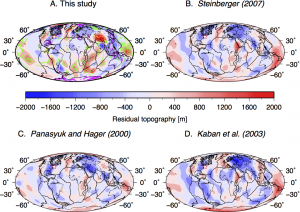Citation
Flament, N., Gurnis, M., & Müller, R. D. (2013). A review of observations and models of dynamic topography. Lithosphere, 5(2), 189-210. doi: 10.1130/L245.1
 Summary
Summary
The topography of Earth is primarily controlled by lateral differences in the density structure of the crust and lithosphere. In addition to this isostatic topography, flow in the mantle induces deformation of its surface leading to dynamic topography. This transient deformation evolves over tens of millions of years, occurs at long wavelength, and is relatively small (<2 km) in amplitude. Here, we review the observational constraints and modeling approaches used to understand the amplitude, spatial pattern, and time dependence of dynamic topography. The best constraint on the present-day dynamic topography induced by sublithospheric mantle flow is likely the residual bathymetry calculated by removing the isostatic effect of oceanic lithospheric structure from observed bathymetry. Increasing knowledge of the thermal and chemical structure of the lithosphere is important to better constrain present-day mantle flow and dynamic topography. Nevertheless, at long wavelengths (>5000 km), we show that there is good agreement between published residual topography fields, including the one described here, and present-day dynamic topography predicted from mantle flow models, including a new one. Residual and predicted fields show peak-to-peak amplitudes of roughly ±2 km and a dominant degree two pattern with high values for the Pacific Ocean, southern Africa, and the North Atlantic and low values for South America, western North America, and Eurasia. The flooding of continental interiors has long been known to require both larger amplitudes and to be temporally phase-shifted compared with inferred eustatic changes. Such long-wavelength inferred vertical motions have been attributed to dynamic topography. An important consequence of dynamic topography is that long-term global sea-level change cannot be estimated at a single passive margin. As a case study, we compare the results of three published models and of our model to the subsidence history of well COST-B2 offshore New Jersey. The <400 ± 45 m amount of anomalous subsidence of this well since 85 Ma is best explained by models that predict dynamic subsidence of the New Jersey margin during that period. Explicitly including the lithosphere in future global mantle flow models should not only facilitate such com
Downloads
Link to download the paper
Download the data here – zip
Files for download include residual topography and dynamic topography grids
Contact
Any questions, please email: nflament@uow.edu.au
![]()
